Store your wood ash lye in metal containers (galvanized or stainless steel) with tight-fitting lids, and keep them in a well-ventilated area away from direct sunlight. You'll need to place containers on sturdy surfaces at least three feet from flammable materials. Always use chemical-resistant gloves and safety goggles when handling lye, and keep vinegar nearby as a neutralizing agent. There's much more to take into account about safe lye storage to protect yourself and others.
Understanding Wood Ash Lye Properties
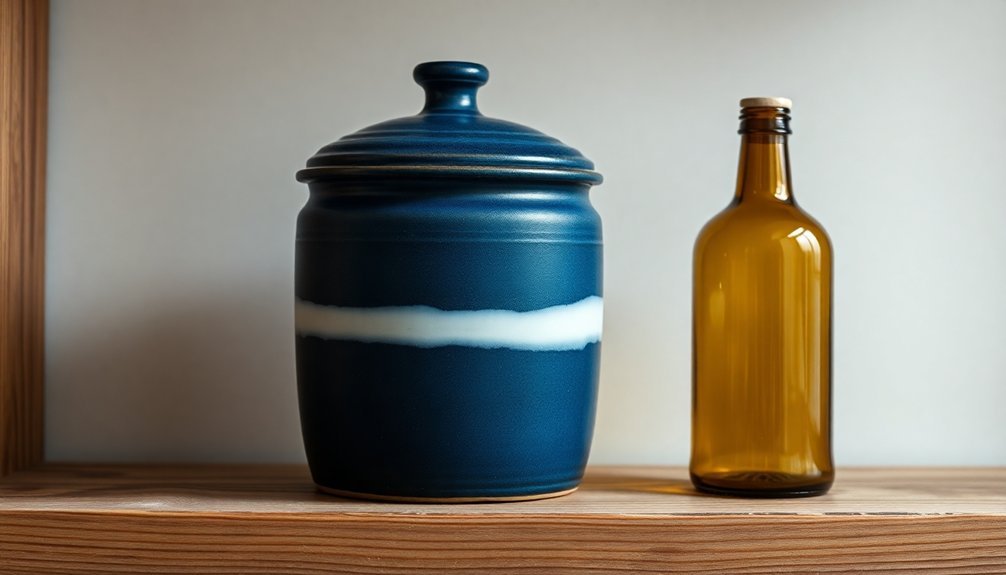
Wood ash lye demands respect due to its potent chemical properties. When you mix wood ash with water, you'll create a highly alkaline solution that's primarily made up of potassium carbonate. This caustic mixture reaches pH levels between 9 and 11, making it capable of causing serious skin burns on contact.
You can test your lye's concentration using a simple egg float test, where the egg's position in the solution indicates its strength. However, you should know that homemade wood ash lye typically won't match the effectiveness of commercial sodium hydroxide.
While this might affect your soap-making results, it's still essential to handle the solution with proper safety measures. Always wear protective gear like gloves and goggles when working with this powerful alkaline substance.
Essential Storage Container Materials
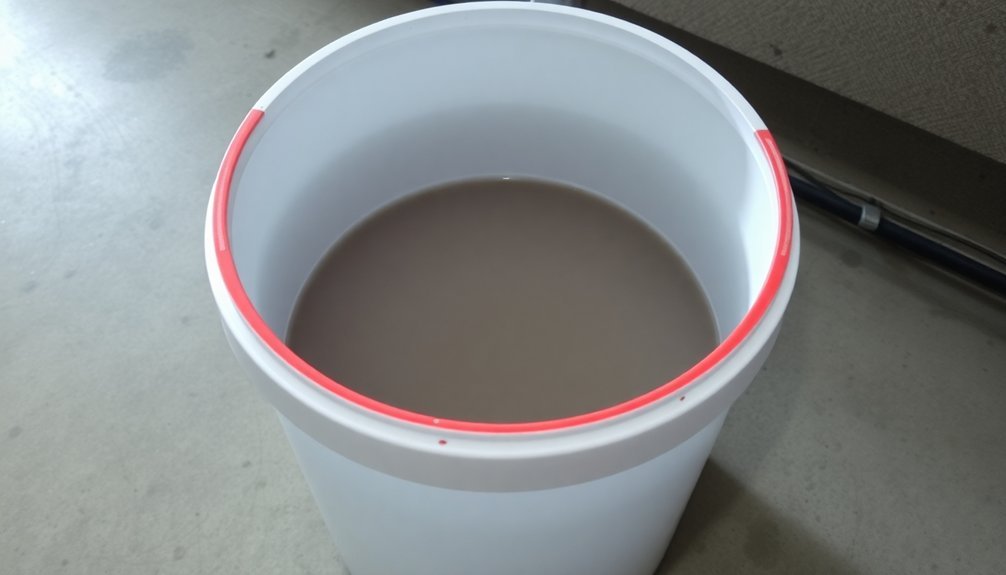
Metal containers stand at the forefront of safe lye storage, with galvanized or stainless steel options being your best choices.
You'll need tight-fitting lids to prevent spills and contamination, while guaranteeing your storage solution remains secure.
Don't use aluminum containers, as they'll react dangerously with the alkaline lye solution.
When setting up your metal container storage system, consider these key elements:
- Position containers elevated on concrete blocks to avoid ground moisture
- Implement a dual-container system – one for cooling, one for filling
- Check regularly for signs of container corrosion or damage
- Confirm lids fit securely and maintain their seal
This systematic approach to container selection and maintenance will help you store wood ash lye safely while preventing potential hazards or contamination risks.
Proper Storage Location Requirements
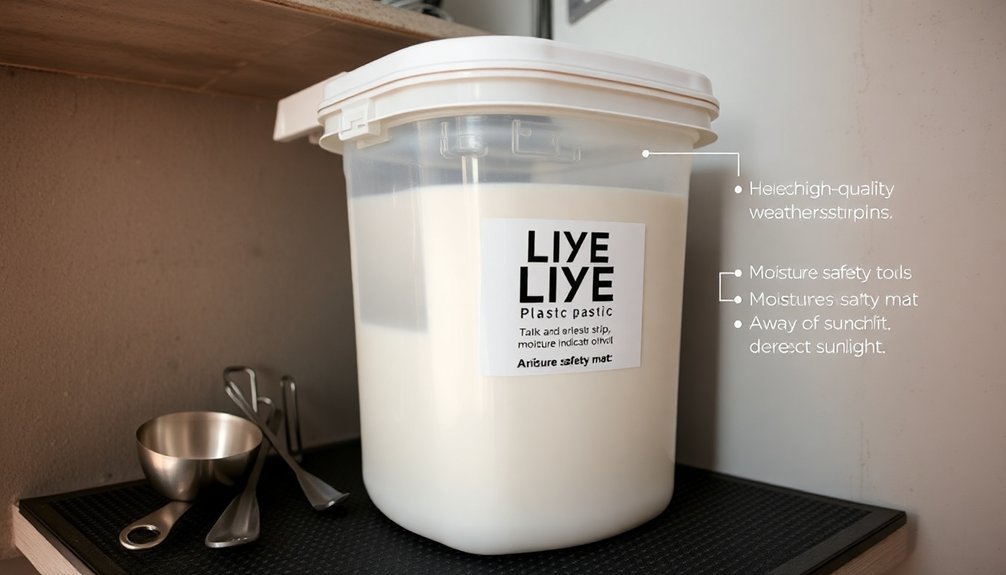
When storing wood ash lye safely, choosing the right location becomes just as crucial as selecting proper containers. You'll need to find a well-ventilated area that's protected from direct sunlight and extreme temperatures to maintain the stability of your solution made from wood ashes.
Place your storage container on a sturdy, level surface, keeping it at least three feet away from any materials that could catch fire. This precaution helps prevent dangerous situations if accidental spills occur.
Make sure your storage area has proper airflow to prevent fume buildup, which can result from ongoing chemical reactions. Don't forget to check your storage space regularly, looking for any signs of container damage or potential leaks that could compromise safety.
A proactive approach to storage location will help protect both you and your environment.
Safety Equipment and Precautions
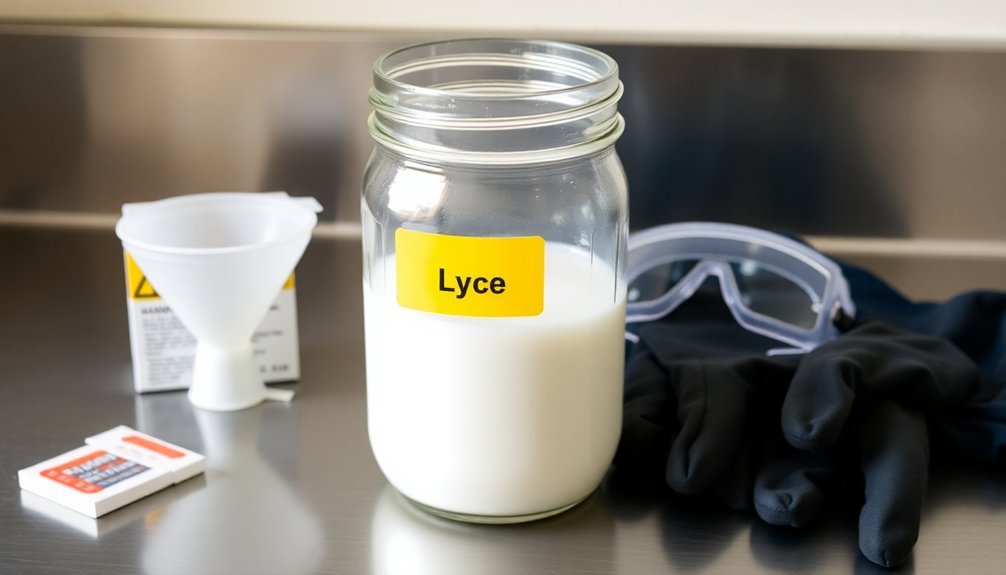
You'll need essential protective gear, including rubber gloves and safety goggles, whenever you handle wood ash lye to shield yourself from its caustic properties.
Keep vinegar within arm's reach during handling as an emergency neutralizing agent for accidental skin contact with the lye.
Your workspace should include clearly marked safety equipment, proper ventilation, and an emergency eye wash station to guarantee quick response to potential accidents.
Protective Gear Requirements
Proper protective gear is absolutely vital when handling wood ash lye due to its highly caustic nature.
When making DIY soap or working with potassium hydroxide solutions, you'll need specific safety equipment to protect yourself from potential chemical burns and injuries.
Required protective gear for handling wood ash lye:
- Chemical-resistant rubber gloves that extend past your wrists
- Safety goggles or a full-face shield to prevent eye damage from splashes
- Long-sleeved clothing and closed-toe shoes to protect your skin
- Protective apron made of chemical-resistant material
Keep vinegar within arm's reach as a neutralizing agent in case of accidental skin contact.
When storing your wood ash lye around the house, always use non-aluminum containers and make sure they're clearly labeled.
This protective gear isn't optional – it's essential for your safety during soap making or garden applications.
Handling Hazardous Materials Safely
Since wood ash lye poses serious health risks, following strict safety protocols during handling and storage is critical.
You'll need to work in a well-ventilated area to prevent inhaling harmful fumes while handling this caustic substance. Always keep vinegar nearby as an emergency neutralizer in case of skin contact.
Store your lye in clearly labeled, airtight containers made of glass or heavy-duty plastic. You'll want to regularly check these containers for any signs of damage or leakage.
Place them in a secure location that's completely inaccessible to children and pets. When you're working with lye, don't forget to wear protective rubber gloves and goggles to shield yourself from potential burns.
If you have leftover lye, dispose of it properly according to your local hazardous waste guidelines.
Emergency Response Protocol
When working with wood ash lye, having an all-encompassing emergency response plan can mean the difference between minor incidents and serious injuries.
You'll need to prepare for potential accidents by establishing clear safety protocols and maintaining essential emergency supplies within arm's reach.
Keep these critical emergency response items readily available:
- A clearly marked bottle of vinegar for immediate neutralization of lye spills or skin contact
- Multiple pairs of thick rubber gloves and protective goggles for handling emergencies
- Well-labeled emergency eyewash station or clean water source for immediate flushing
- A detailed emergency contact list including poison control numbers and nearby medical facilities
Always guarantee proper ventilation in your work area and maintain a designated spill kit with absorbent materials and neutralizing agents.
Temperature and Environmental Controls
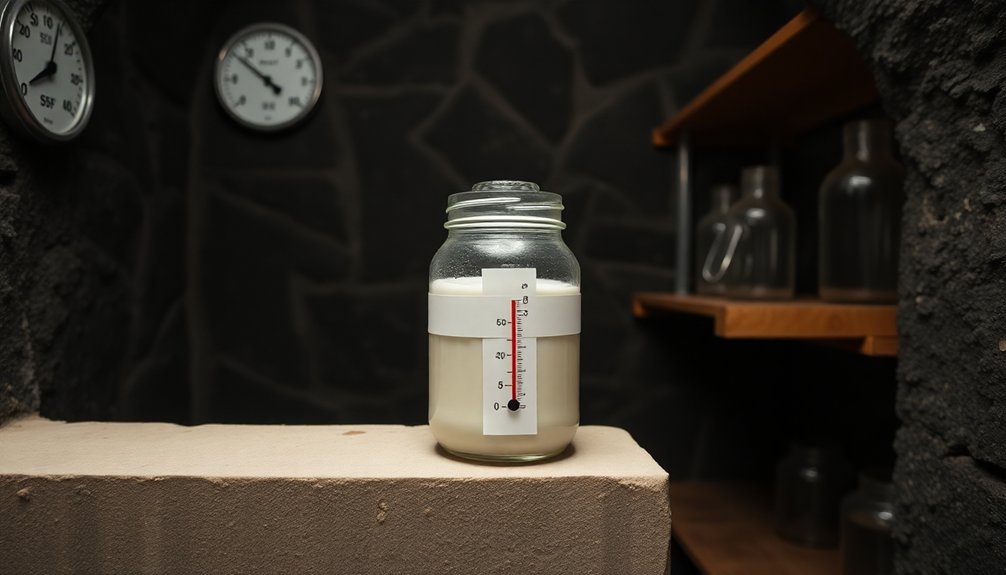
Keep your wood ash lye storage area at a steady temperature below 75°F (24°C) to maintain its chemical stability and prevent unwanted reactions.
You'll need to control humidity levels by choosing a dry, well-ventilated space and using moisture-absorbing materials like silica gel packets in your storage area.
Select a cool basement or storage room away from direct sunlight and heat sources, ensuring there's adequate airflow to prevent fume buildup while protecting the lye from temperature swings that could trigger condensation.
Temperature Range Guidelines
To maintain wood ash lye's stability and effectiveness, proper temperature control plays an essential role in safe storage. You'll need to keep your storage area consistently below 70°F (21°C) to prevent unwanted chemical reactions and maintain the lye's potency.
- Store your lye in a cool basement or cellar where temperatures remain stable throughout the year.
- Place a thermometer in your storage area to monitor temperature fluctuations.
- Install insulation around storage containers if you're in a cold climate to prevent freezing.
- Consider using a small dehumidifier nearby to control moisture levels that can affect temperature stability.
Don't expose your lye to direct sunlight or areas with frequent temperature changes, as these conditions can compromise its safety and effectiveness.
Regular monitoring of storage conditions will help guarantee your lye remains stable.
Humidity Control Methods
Along with temperature management, proper humidity control stands as an essential safeguard for wood ash lye storage.
You'll need to store your wood ash lye in airtight, moisture-resistant containers, such as glass jars or heavy-duty plastic bins. Place these containers in a well-ventilated area that's consistently cool and dry. Avoid damp locations that could compromise the lye's effectiveness.
To enhance moisture protection, you can add silica gel packets inside your storage containers. These desiccants will help absorb any excess humidity that might seep in.
Don't forget to inspect your storage setup regularly – check for condensation inside containers, confirm lids remain properly sealed, and verify there's no clumping of the lye. If you notice any signs of moisture exposure, transfer the lye to a new, dry container immediately.
Storage Location Requirements
Selecting the right storage location for wood ash lye requires careful attention to both temperature and environmental factors.
You'll need to create a controlled environment that maintains the lye's chemical stability while protecting your safety.
- Choose a cool, dry storage space away from windows and direct sunlight to prevent chemical breakdown and maintain the lye's effectiveness.
- Set up your storage area in a well-ventilated location where fumes can safely dissipate, preventing dangerous vapor buildup.
- Position your lye container at least three feet from any flammable or combustible materials to minimize fire risks.
- Select an area that maintains consistent temperature and humidity levels, avoiding spaces like basements or garages that experience frequent environmental fluctuations.
Remember to regularly check your storage container for any signs of damage or leakage to guarantee continued safe storage.
Container Inspection and Maintenance
Proper maintenance of your wood ash lye storage container plays an essential role in ensuring long-term safety.
You'll need to regularly examine your metal container for any signs of rust, damage, or leakage that could compromise its integrity.
Make sure your container's lid fits securely to prevent accidental spills and keep moisture out, as water can react dangerously with lye.
You should elevate the container on stable surfaces like concrete blocks, keeping it away from weeds and flammable materials.
Maintain a three-foot clearance from any combustible surfaces to minimize fire risks.
Don't forget to check the contents periodically – removing any unburnt wood pieces you find, as they can affect your lye's quality and safety.
These simple inspection steps will help protect you and your workspace.
Labeling and Documentation Systems
Because wood ash lye can be hazardous if mishandled, implementing a thorough labeling and documentation system is essential for safe storage.
You'll need to establish clear identification methods and maintain detailed records of your lye solutions.
- Label each container with the content specifics, preparation date, and concentration level, using waterproof materials that won't deteriorate from spills.
- Apply color-coded tags or stickers to distinguish between different lye strengths – for example, red for concentrated solutions and green for diluted ones.
- Keep a dedicated logbook in a durable binder, recording pH measurements, mixture ratios, and any modifications you make.
- Set up a regular schedule to review and update your labels and documentation, ensuring all information stays current and safety protocols remain effective.
Your careful attention to labeling and documentation will help prevent accidents and maintain safe handling practices.
Emergency Response Protocols
While working with wood ash lye requires careful handling, knowing exactly what to do in an emergency can prevent serious injuries.
If you get lye on your skin, immediately rinse the area with water for at least 15 minutes. Keep vinegar nearby as it can neutralize minor lye burns.
For eye contact, flush with clean water for 15 minutes and seek emergency medical care right away.
If someone swallows lye, don't induce vomiting. Instead, have them drink water or milk to dilute the substance and contact poison control immediately.
You'll want to post these emergency procedures where you store and handle lye, ensuring everyone who uses it knows the proper response steps.
Long-term Storage Considerations
For long-term storage of wood ash lye, you'll need an airtight glass or plastic container that's clearly labeled and regularly inspected for damage.
Your storage location should be a cool, dark space away from sunlight, where temperature remains stable and humidity can be controlled to prevent moisture absorption.
You'll want to check the container's seal periodically to maintain the lye's chemical properties and keep it safely locked away from children and pets.
Container Materials and Safety
Since wood ash lye is highly caustic, choosing the right storage container proves essential for both safety and effectiveness.
You'll need to select non-reactive materials like glass, ceramic, or HDPE plastic to prevent dangerous chemical reactions and contamination of your lye solution.
When storing your wood ash lye, follow these critical safety measures:
- Use containers with tight-fitting lids that seal completely to prevent spills and evaporation.
- Apply clear "Lye" labels with hazard warnings to alert others of the dangerous contents.
- Keep the container in a cool, dry location away from direct sunlight.
- Place it high enough to be out of children's and pets' reach.
Never store lye in aluminum or metal containers, as they'll corrode and release harmful substances into your solution.
Humidity Control Methods
Because wood ash lye readily absorbs moisture from the air, proper humidity control becomes essential for long-term storage. You'll need to store your lye in an airtight container, preferably made of glass or HDPE, and keep it in a cool, dry location away from direct sunlight.
| Control Method | Purpose |
|---|---|
| Silica Gel Packets | Absorbs excess moisture inside container |
| Airtight Seals | Prevents external humidity infiltration |
| Regular Inspection | Identifies moisture issues early |
Monitor your storage container regularly for signs of condensation or clumping, which indicate moisture contamination. If you notice these issues, transfer the lye to a fresh, dry container immediately. By implementing these humidity control measures, you'll maintain the lye's effectiveness and prevent degradation that could compromise its usability over time.
Temperature and Location Requirements
When storing wood ash lye long-term, maintaining proper temperature and location conditions proves critical for both safety and effectiveness.
You'll need to keep your lye solution in a cool environment below 70°F (21°C) to prevent degradation and evaporation.
Choose your storage location carefully, considering these essential requirements:
- Select a well-ventilated area that's free from moisture and away from direct sunlight.
- Position containers at least three feet from any flammable materials.
- Use a dedicated storage space that's consistently cool and dry year-round.
- Guarantee easy access for regular inspections while maintaining security.
Remember to use only corrosion-resistant containers made of glass or high-density polyethylene, and always label them clearly.
Proper temperature control and strategic placement will help maintain your lye's potency while keeping your storage area safe.
Chemical Stability Guidelines
To maintain the chemical stability of wood ash lye, you'll need to store it in a tightly sealed, non-reactive container made of glass or heavy-duty plastic. This prevents contamination and keeps moisture from compromising the solution's effectiveness.
Store wood ash lye in sealed glass or heavy-duty plastic containers to maintain stability and prevent moisture contamination.
Check your storage container regularly for any signs of damage or leaks. If you notice cracks, warping, or deterioration, transfer the lye to a new container immediately.
Remember that wood ash lye is highly caustic, so you'll want to label your container clearly and keep it away from areas where children or pets might access it.
When you're working with the lye solution, don't forget to protect yourself. Always wear gloves and safety goggles to prevent burns and eye injuries. The solution's alkaline nature makes it dangerous if it comes into contact with your skin.
Storage Area Ventilation Requirements
Proper storage of wood ash lye goes beyond just selecting the right container – you'll need a well-ventilated area to keep it safely.
The storage space must allow adequate air circulation to prevent dangerous fume buildup, especially when the lye interacts with water.
When setting up your storage area, follow these essential ventilation requirements:
- Choose an open, dry space with natural airflow away from direct sunlight
- Keep your container's lid breathable or vented to allow continuous air exchange
- Maintain a 3-foot clearance from any flammable materials to prevent fire risks
- Check the area regularly for unwanted moisture buildup that could trigger hazardous gas formation
Container Size and Capacity Planning
Selecting the right container size for wood ash lye storage can make or break your safety setup.
You'll need containers that hold between 1 to 5 gallons, depending on how much lye you're planning to produce and use regularly.
Choose containers made from non-reactive materials like glass or high-density polyethylene to prevent unwanted chemical reactions.
Always store wood ash lye in glass or high-density polyethylene containers to maintain chemical stability and prevent dangerous reactions.
You'll want to verify your container has an airtight lid that seals securely to protect the lye from moisture and air exposure, which can reduce its effectiveness.
Don't forget to clearly label each container with "Lye" to prevent accidents.
Before settling on a container size, consider your long-term storage needs and inspect your containers regularly for damage or leaks to maintain a safe storage environment.
Handling and Transfer Procedures
When handling wood ash lye, safety must be your top priority since even small splashes can cause severe chemical burns.
You'll need to take specific precautions during the mixing and transfer process to guarantee your protection.
- Select a non-aluminum container for all handling steps – aluminum reacts with lye and can create dangerous situations.
- Put on thick rubber gloves and protective goggles before you start working with the solution.
- Pour distilled water slowly into your sifted ash while stirring constantly to create an even mixture.
- Let the solution settle completely before transferring the clear liquid to a mason jar.
Once you've collected the clear lye liquid, carefully pour it into a labeled mason jar with a tight-fitting lid.
Store it securely where children and pets can't access it.
Frequently Asked Questions
How Do You Store Lye Safely?
You'll need to store lye in a labeled, airtight glass or HDPE container in a cool, dry, well-ventilated area. Keep it locked away from kids and pets, and always wear protective gear when handling.
Where to Dump Wood Ash?
You can dump cooled wood ash in a designated yard pile away from structures, mix it into your garden soil, or take it to a local disposal facility. Keep ashes in covered metal containers until disposal.
Does Wood Ash Turn to Lye When Wet?
Yes, when you mix wood ash with water, it'll create lye solution through a chemical reaction. The water dissolves potassium and sodium salts in the ash, producing an alkaline substance that's highly caustic.
Does Wood Ash Repel Mice?
Yes, wood ash can repel mice. You'll find it effective when you sprinkle it around entry points and burrows. It works because mice don't like its abrasive texture and strong smell, but it's not foolproof.
In Summary
Store your wood ash lye in a high-quality HDPE plastic or stainless steel container with a secure, airtight lid. You'll need to keep it in a cool, dry, well-ventilated area away from kids, pets, and other chemicals. Don't forget to clearly label the container with hazard warnings and wear protective gear when handling it. With proper storage and safety measures, you're protecting yourself and others from this caustic substance.


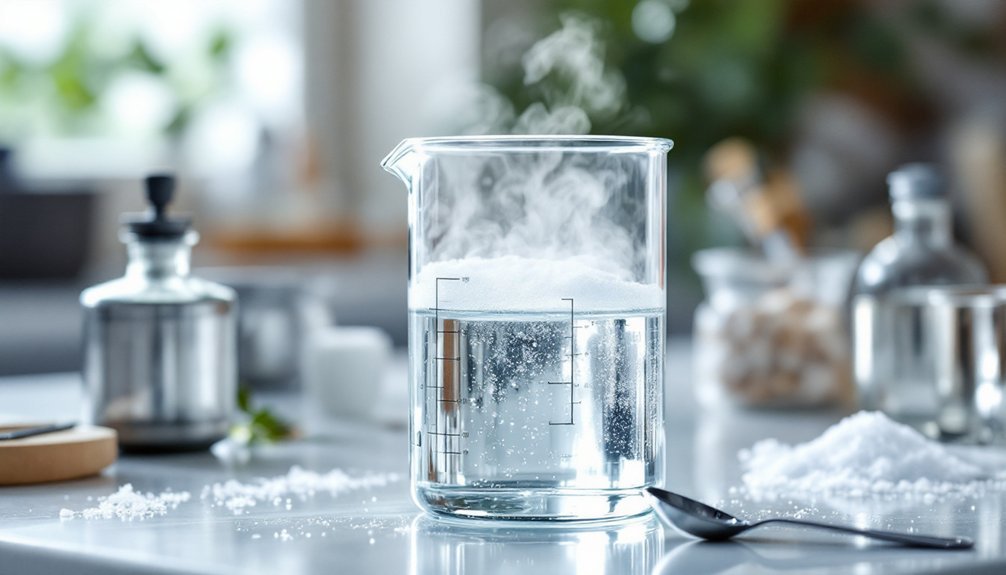


Leave a Reply